Preparation of Monolithic LaFeO3 and Catalytic Oxidation of Toluene
Abstract
1. Introduction
2. Materials and Methods
2.1. Materials
2.2. Synthesis of LaFeO3 Powders
2.3. Synthesis of Monolithic Catalysts
2.4. Characterizations
2.5. Catalytic Oxidation of Toluene
3. Results and Discussion
3.1. XRD Characterization
3.2. Morphology Analysis
3.3. BET Measurements
3.4. Structural Composition Analysis of Materials
3.5. Catalytic Performance
4. Conclusions
Author Contributions
Funding
Institutional Review Board Statement
Informed Consent Statement
Data Availability Statement
Acknowledgments
Conflicts of Interest
References
- Morales Torres, S.; Carrasco Marin, F.; Perez Cadenas, A.F. Coupling Noble Metals and Carbon Supports in the Development of Combustion Catalysts for the Abatement of BTX Compounds in Air Streams. Catalysts 2015, 5, 0774. [Google Scholar] [CrossRef]
- Li, W.B.; Wang, J.X.; Gong, H. Catalytic combustion of VOCs on non-noble metal catalysts. Catal. Today 2009, 148, 81–87. [Google Scholar] [CrossRef]
- Qiu, K.; Yang, L.; Lin, J. Historical industrial emissions of non-methane volatile organic compounds in China for the period of 1980–2010. Atmos. Environ. 2014, 86, 102–112. [Google Scholar] [CrossRef]
- Rajabi, H.; Hadi, M.M.; Mandal, P. Emissions of volatile organic compounds from crude oil processing–Global emission inventory and environmental release. Sci. Total Environ. 2020, 727, 138654. [Google Scholar] [CrossRef]
- Kamal, M.S.; Razzak, S.A.; Hossain, M.M. Catalytic oxidation of volatile organic compounds (VOCs)—A review. Atmos. Environ. 2016, 140, 117–134. [Google Scholar] [CrossRef]
- Thepanondh, S.; Varoonphan, J.; Sarutichart, P. Airborne Volatile Organic Compounds and Their Potential Health Impact on the Vicinity of Petrochemical Industrial Complex. Water Air Soil Pollut. 2011, 214, 83–92. [Google Scholar] [CrossRef]
- Luo, D.; Yi, P.; Chen, A. Indoor Pollution Caused by Building and Decorative Materials and Their Preventive Measure. China Saf. Sci. 2003, 13, 66–68. [Google Scholar]
- He, C.; Cheng, J.; Zhang, X. Recent Advances in the Catalytic Oxidation of Volatile Organic Compounds: A Review Based on Pollutant Sorts and Sources. Chem. Rev. 2019, 119, 4471–4568. [Google Scholar] [CrossRef]
- Mo, J.; Zhang, Y.; Xu, Q. Photocatalytic purification of volatile organic compounds in indoor air: A literature review. Atmos. Environ. 2009, 43, 2229–2246. [Google Scholar] [CrossRef]
- Li, G.S.; Zhang, D.Q.; Yu, J.C. An Efficient Bismuth Tungstate Visible-Light-Driven Photocatalyst for Breaking Down Nitric Oxide. Environ. Sci. Technol. 2010, 44, 4276–4281. [Google Scholar] [CrossRef]
- Morales-Torres, S.; Maldonado-Hódar, F.J.; Pérez-Cadenas, A.F.; Carrasco-Marín, F. Design of low-temperature Pt-carbon combustion catalysts for VOC’s treatments. J. Hazard. Mater. 2010, 183, 814–822. [Google Scholar] [CrossRef] [PubMed]
- Tsai, W.T. An overview of health hazards of volatile organic compounds regulated as indoor air pollutants. Rev. Environ. Health 2019, 34, 81–89. [Google Scholar] [CrossRef] [PubMed]
- Niu, Q.; Li, B.; Xu, X. Research progress in catalytic combustion of volatile organic compounds. Mod. Chem. Ind. 2013, 33, 19–23. [Google Scholar]
- Hongyan, P.A.N.; Yu, Z.; Qian, L.I.N. Advance in non-noble metal catalysts for catalytic combustion of volatile organic compounds. Chem. Ind. Eng. Prog. 2011, 30, 1726–1732, 1748. [Google Scholar]
- Wang, C.C.; Li, J.R.; Lv, X.L. Photocatalytic organic pollutants degradation in metal-organic frameworks. Energy Environ. Sci. 2014, 7, 2831–2867. [Google Scholar] [CrossRef]
- Zhao, X.X.; Li, J.Z.; Li, X. Design of metal-organic frameworks (MOFs) -based photocatalyst for solar fuel production and photo-degradation of pollutants. Chin. J. Catal. 2021, 42, 872–903. [Google Scholar] [CrossRef]
- Busca, G.; Berardinelli, S.; Resini, C. Technologies for the removal of phenol from fluid streams: A short review of recent developments. J. Hazard. Mater. 2008, 160, 265–288. [Google Scholar] [CrossRef]
- Shou, T.; Li, Y.; Bernards, M.T. Degradation of gas-phase o-xylene via combined non-thermal plasma and Fe doped LaMnO3 catalysts: Byproduct control. J. Hazard. Mater. 2020, 387, 121750. [Google Scholar] [CrossRef]
- Hosseini, S.A.; Sadeghi, M.T.; Alemi, A. Synthesis, Characterization, and Performance of LaZnxFe1−xO3 Perovskite Nanocatalysts for toluene combustion. Chin. J. Catal. 2010, 31, 747–750. [Google Scholar] [CrossRef]
- Lv, Y.; Cheng, B.; Yang, H. Chemical looping partial oxidation (CLPO) of toluene on LaFeO3 perovskites for tunable syngas production. Chem. Eng. J. 2023, 451, 138968. [Google Scholar] [CrossRef]
- Tarjomannejad, A.; Farzi, A.; Niaei, A. An experimental and kinetic study of toluene oxidation over LaMn1−xBxO3 and La0.8A0.2Mn0.3B0.7O3 (A = Sr, Ce and B = Cu, Fe) nano-perovskite catalysts. Korean J. Chem. Eng. 2016, 33, 2628–2637. [Google Scholar] [CrossRef]
- Zhao, L.; Jiang, L.; Huang, Y. Mechanism investigation of three-dimensional porous A-site substituted La1−xCoxFeO3 catalysts for simultaneous oxidation of NO and toluene with H2O. Appl. Surf. Sci. 2022, 578, 151977. [Google Scholar] [CrossRef]
- Penuelas, J.; Asensio, D.; Tholl, D. Biogenic volatile emissions from the soil. Plant Cell Environ. 2014, 37, 1866–1891. [Google Scholar] [CrossRef]
- Kim, H.S.; Kim, H.J.; Kim, J.H. Noble-Metal-Based Catalytic Oxidation Technology Trends for Volatile Organic Compound (VOC) Removal. Catalysts 2022, 12, 63. [Google Scholar] [CrossRef]
- Wu, P.; Jin, X.; Qiu, Y. Recent Progress of Thermocatalytic and Photo/Thermocatalytic Oxidation for VOCs Purification over Manganese-based Oxide Catalysts. Environ. Sci. Technol. 2021, 55, 4268–4286. [Google Scholar] [CrossRef]
- Tang, Y.; Tao, Y.; Zhou, T. Direct Z-scheme La1−xCexMnO3 catalyst for photothermal degradation of toluene. Environ. Sci. Pollut. Res. 2019, 26, 36832–36844. [Google Scholar] [CrossRef]
- Padilla, O.; Munera, J.; Gallego, J. Approach to the Characterization of Monolithic Catalysts Based on La Perovskite-like Oxides and Their Application for VOC Oxidation under Simulated Indoor Environment Conditions. Catalysts 2022, 12, 168. [Google Scholar] [CrossRef]
- Gao, B.; Deng, J.; Liu, Y. Mesoporous LaFeO3 catalysts for the oxidation of toluene and carbon monoxide. Chin. J. Catal. 2013, 34, 2223–2229. [Google Scholar] [CrossRef]
- Zhao, S.; Wang, L.; Wang, Y. Hierarchically porous LaFeO3 perovskite prepared from the pomelo peel bio-template for catalytic oxidation of NO. J. Phys. Chem. Solids 2018, 116, 43–49. [Google Scholar] [CrossRef]
- Kajama, M.N.; Shehu, H.; Okon, E. VOC oxidation in excess of oxygen using flow-through catalytic membrane reactor. Int. J. Hydrogen Energy 2016, 41, 16529–16534. [Google Scholar] [CrossRef]
- Wu, M.; Chen, S.; Xiang, W. Oxygen vacancy induced performance enhancement of toluene catalytic oxidation using LaFeO3 perovskite oxides. Chem. Eng. J. 2020, 387, 124101. [Google Scholar] [CrossRef]
- Kumar, M.; Thapa, K.B.; Singh, P. Long-range surface plasmon resonance biosensors with cytop/Al/Perovskite and cytop/Al/MoS2 configurations. Phys. Scr. 2022, 97, 055501. [Google Scholar] [CrossRef]
- Ayesh, A.I.; Alghamdi, S.A.; Salah, B. High sensitivity H2S gas sensors using lead halide perovskite nanoparticles. Results Phys. 2022, 35, 105333. [Google Scholar] [CrossRef]
- Lee, K.Y.; Hsieh, J.C.; Chen, C.A. Ultrasensitive detection of hydrogen sulfide gas based on perovskite vertical channel chemo-sensor. Sens. Actuators B Chem. 2021, 326, 128988. [Google Scholar] [CrossRef]
- Orera, A.; Slater, P.R. New Chemical Systems for Solid Oxide Fuel Cells. Chem. Mater. 2009, 22, 675–690. [Google Scholar] [CrossRef]
- Azalim, S.; Brahmi, R.; Agunaou, M. Washcoating of cordierite honeycomb with Ce-Zr-Mn mixed oxides for VOC catalytic oxidation. Chem. Eng. J. 2013, 223, 536–546. [Google Scholar] [CrossRef]
- Thommes, M.; Kaneko, K.; Neimark, A.V. Physisorption of gases, with special reference to the evaluation of surface area and pore size distribution. Pure Appl. Chem. 2015, 87, 1051–1069. [Google Scholar] [CrossRef]
- Guo, Y.; Chen, C.; Ling, L. Visible-light-driven photo-Fenton degradation of ceftriaxone sodium using SnS2/LaFeO3 composite photocatalysts. New J. Chem. 2021, 45, 18933–18946. [Google Scholar] [CrossRef]
- Wang, X.T.; Li, Y.; Zhang, X.Q. Design and fabrication of NiS/LaFeO3 heterostructures for high efficient photodegradation of organic dyes. Appl. Surf. Sci. 2020, 504, 144363. [Google Scholar] [CrossRef]
- Manchala, S.; Gandamalla, A.; Vempuluru, N.R. High potential and robust ternary LaFeO3/CdS/carbon quantum dots nanocomposite for photocatalytic H2 evolution under sunlight illumination. J. Colloid Interface Sci. 2021, 583, 255–266. [Google Scholar] [CrossRef]
- Wiranwetchayan, O.; Promnopas, S.; Phadungdhitidhada, S. Characterization of perovskite LaFeO3 synthesized by microwave plasma method for photocatalytic applications. Ceram. Int. 2019, 45, 4802–4809. [Google Scholar] [CrossRef]
- Lv, C.; Chen, H.; Hu, M. Nano-oxides washcoat for enhanced catalytic oxidation activity toward the perovskite-based monolithic catalyst. Environ. Sci. Pollut. Res. 2021, 28, 37142–37157. [Google Scholar] [CrossRef] [PubMed]
- Cui, X.; Yang, H.; Zhang, J. Characterization and performance of Ca-substituted La1−xCaxCoO3−δ perovskite for efficient catalytic oxidation of toluene. Catal. Lett. 2021, 151, 3323–3333. [Google Scholar] [CrossRef]
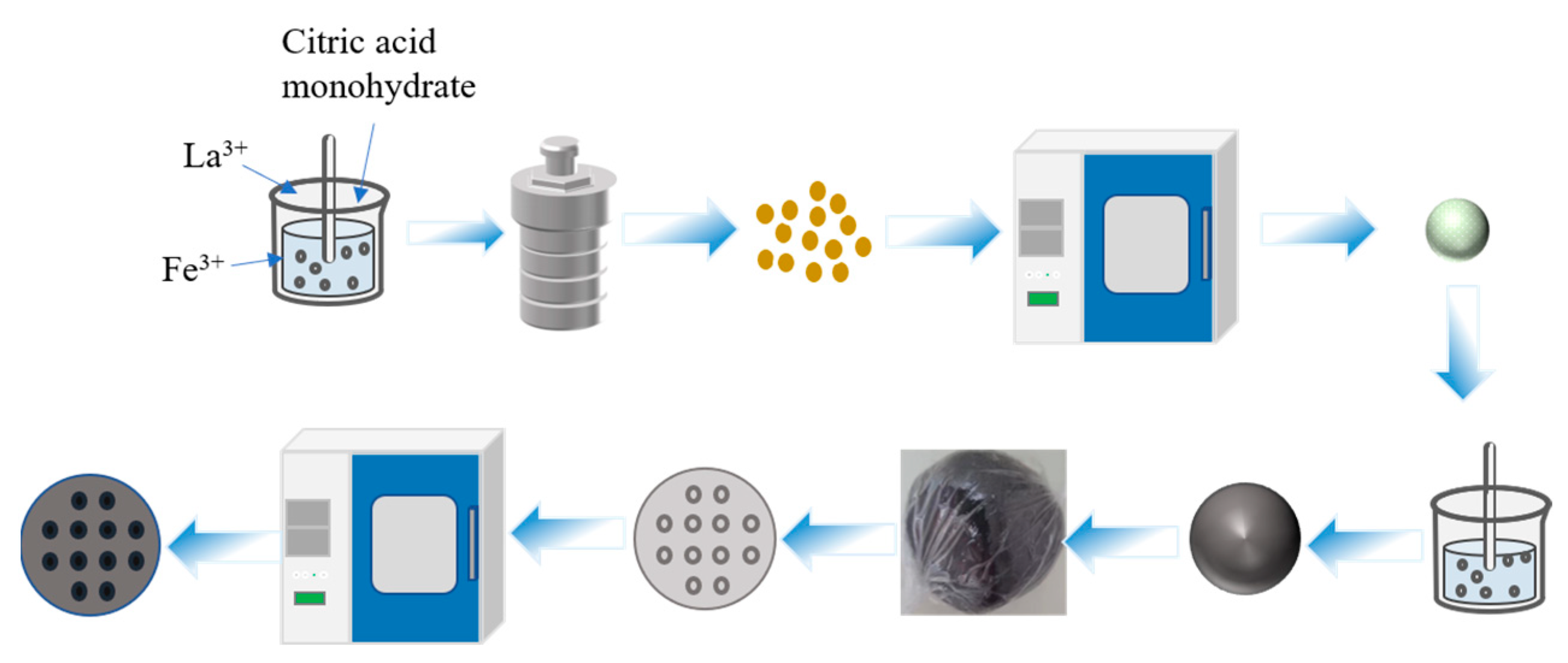
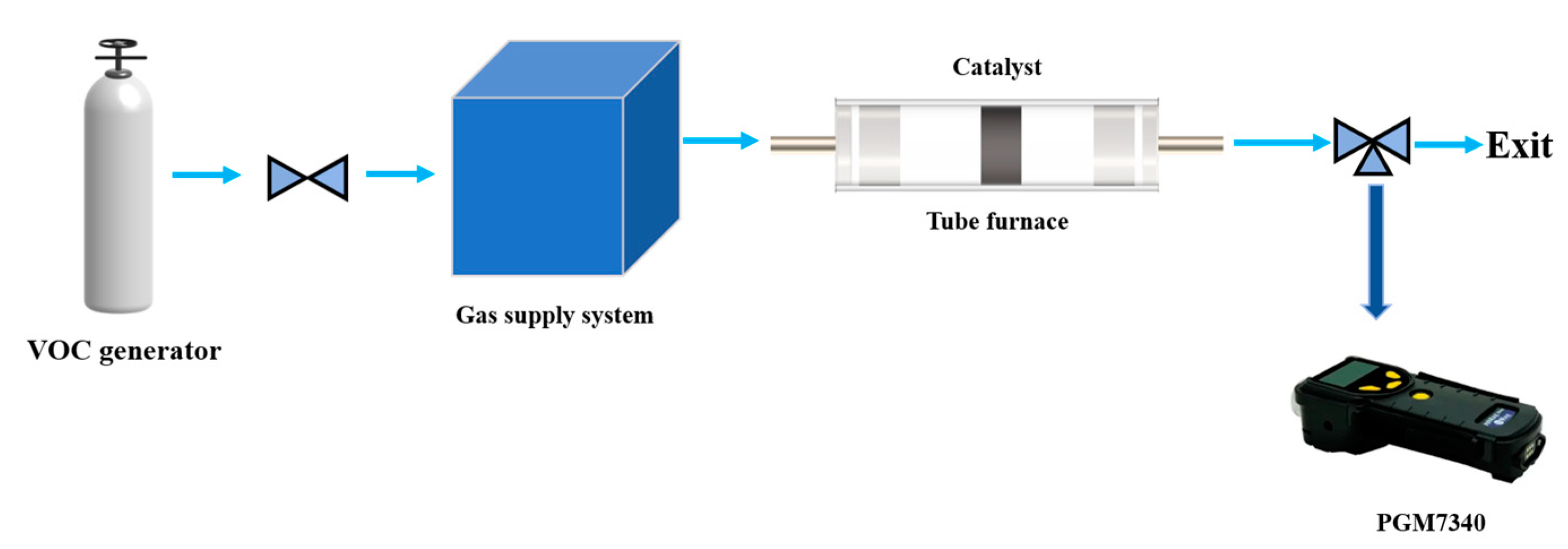

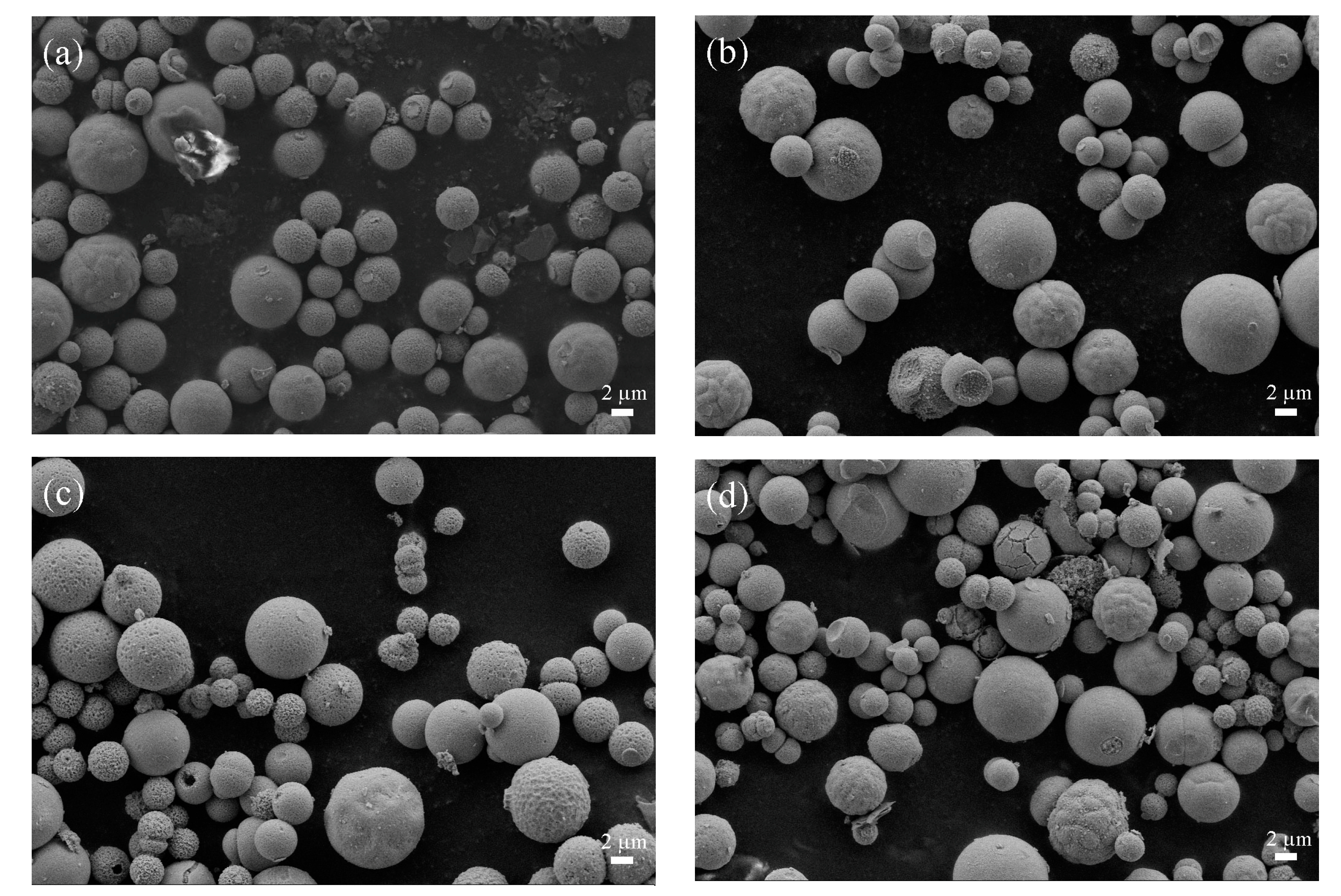
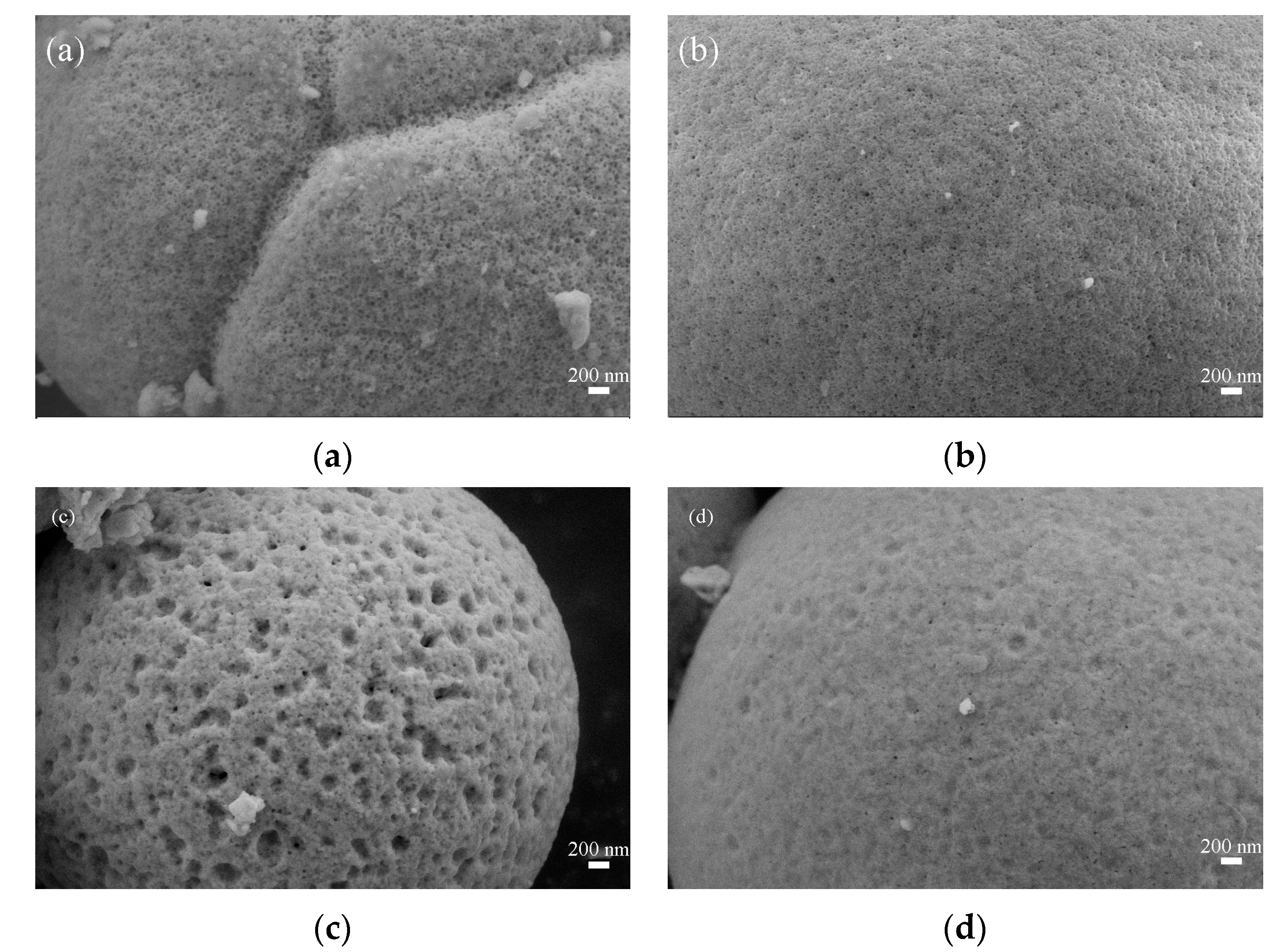
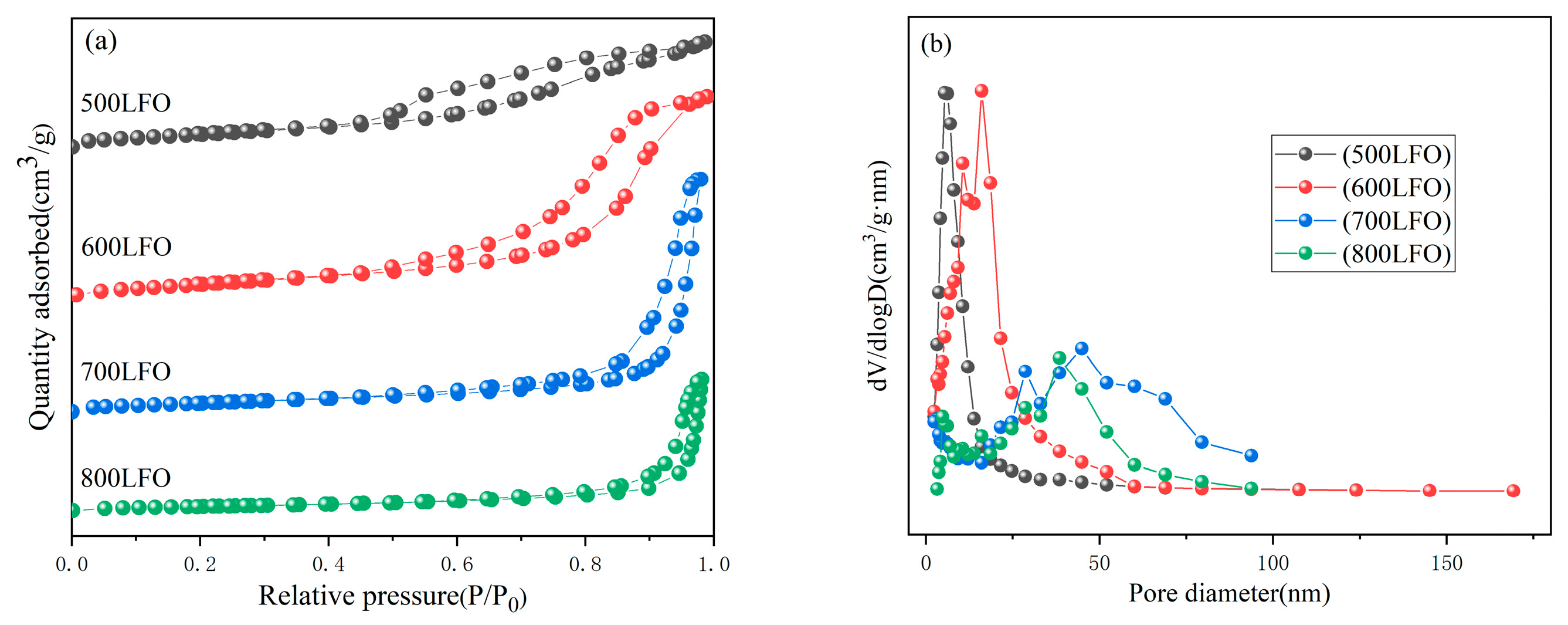
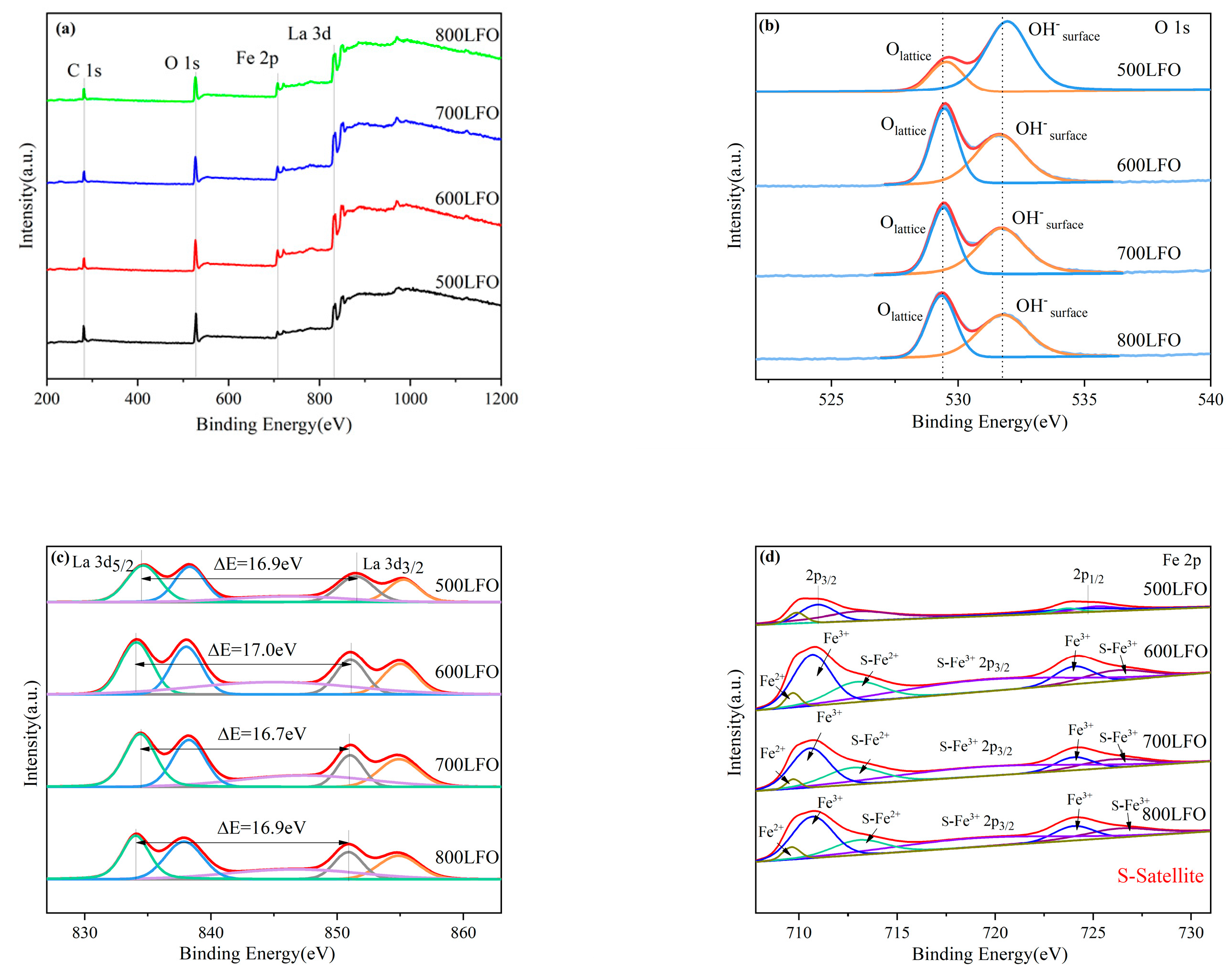

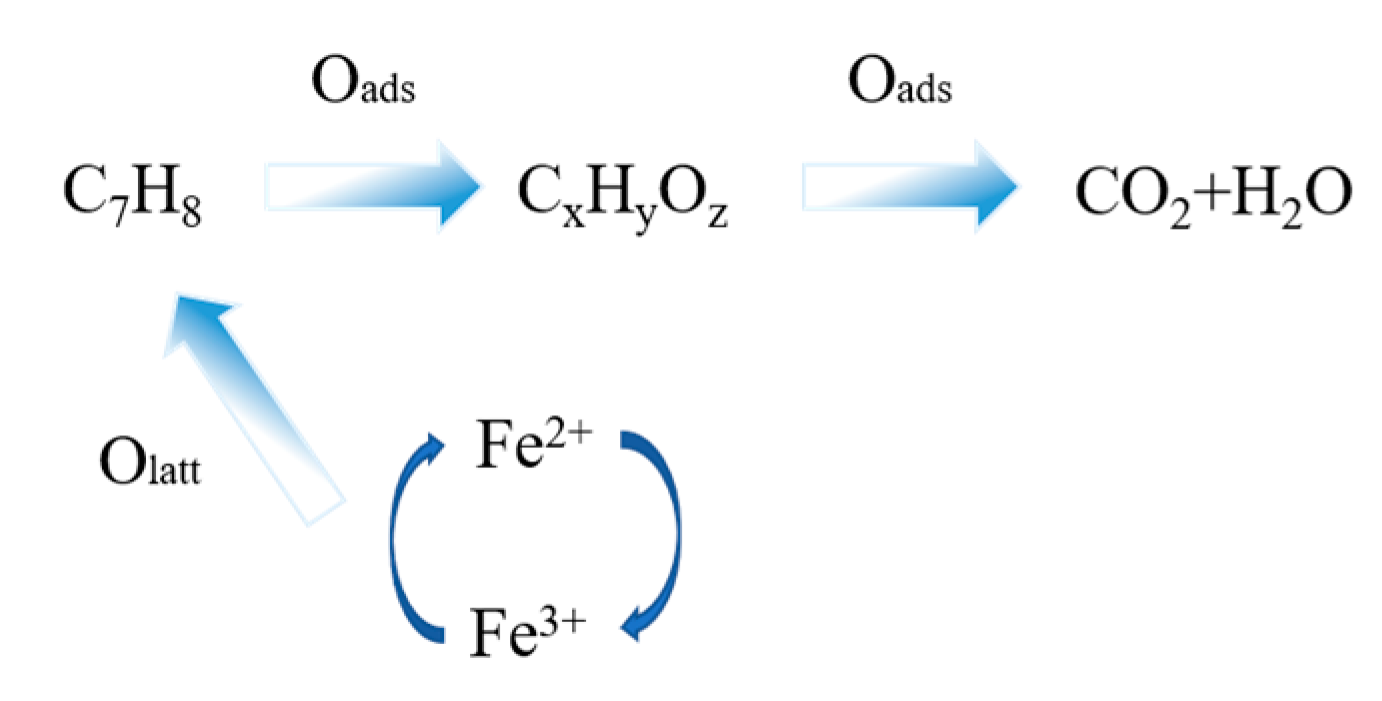
| Catalysts | BET Surface Area (m2/g) | Average Pore Size (nm) | Total Pore Volume (cm3/g) |
|---|---|---|---|
| 500 LFO | 13.42 | 8.99 | 0.04 |
| 600 LFO | 18.91 | 13.66 | 0.08 |
| 700 LFO | 23.41 | 27.32 | 0.09 |
| 800 LFO | 6.03 | 33.12 | 0.05 |
| Catalysts | Binding Energy (eV) | ||||||||
|---|---|---|---|---|---|---|---|---|---|
| La3+ | La3+ | Fe3+ | Fe3+ | Fe2+ | Oads | Olatt | Fe2+/Fe3+ | Oads/Olatt | |
| 3d 5/2 | 3d 3/2 | 2p 3/2 | 2p 1/2 | 2p 3/2 | 1 s | 1 s | |||
| 500 LFO | 834.2/838.4 | 851.5/855.2 | 710.9/719.8 | 724.5/725.5 | 709.9/713.1 | 529.6 | 531.9 | 0.68 | 2.63 |
| 600 LFO | 834.1/838.1 | 851.1/855 | 710.7/719.5 | 724.2/726.3 | 709.7/713.1 | 529.5 | 531.8 | 0.70 | 1.21 |
| 700 LFO | 834.3/838.2 | 851/854.9 | 710.6/719.3 | 724/726.5 | 709.7/712.9 | 529.4 | 531.7 | 0.78 | 1.62 |
| 800 LFO | 834/837.8 | 850.9/854.8 | 710.7/719.1 | 724.2/726.7 | 709.6/713.2 | 529.3 | 531.6 | 0.71 | 1.26 |
| Catalysts | Toluene Oxidation Activity (°C) | ||
|---|---|---|---|
| T10% | T50% | T90% | |
| 500 LFO | 87 | 383 | / |
| 600 LFO | 83 | 285 | 450 |
| 700 LFO | 76 | 253 | 420 |
| 800 LFO | 79 | 259 | 436 |
| Without catalyst | 241 | / | / |
Disclaimer/Publisher’s Note: The statements, opinions and data contained in all publications are solely those of the individual author(s) and contributor(s) and not of MDPI and/or the editor(s). MDPI and/or the editor(s) disclaim responsibility for any injury to people or property resulting from any ideas, methods, instructions or products referred to in the content. |
© 2023 by the authors. Licensee MDPI, Basel, Switzerland. This article is an open access article distributed under the terms and conditions of the Creative Commons Attribution (CC BY) license (https://creativecommons.org/licenses/by/4.0/).
Share and Cite
Han, S.; Tao, Y.; Liu, Y.; Lu, Y.; Pan, Z. Preparation of Monolithic LaFeO3 and Catalytic Oxidation of Toluene. Materials 2023, 16, 3948. https://doi.org/10.3390/ma16113948
Han S, Tao Y, Liu Y, Lu Y, Pan Z. Preparation of Monolithic LaFeO3 and Catalytic Oxidation of Toluene. Materials. 2023; 16(11):3948. https://doi.org/10.3390/ma16113948
Chicago/Turabian StyleHan, Songlin, Yaqiu Tao, Yunfei Liu, Yinong Lu, and Zhigang Pan. 2023. "Preparation of Monolithic LaFeO3 and Catalytic Oxidation of Toluene" Materials 16, no. 11: 3948. https://doi.org/10.3390/ma16113948
APA StyleHan, S., Tao, Y., Liu, Y., Lu, Y., & Pan, Z. (2023). Preparation of Monolithic LaFeO3 and Catalytic Oxidation of Toluene. Materials, 16(11), 3948. https://doi.org/10.3390/ma16113948






